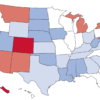New research models the rapid and expansive spread of suicidal behaviors following the suicides of Robin Williams in 2014, and of Kate Spade and Anthony Bourdain, which occurred three days apart in 2018.
Columbia University researchers developed a computer model to examine the dynamics underlying suicide contagion. They found that both the 2014 and 2018 events led to large increases in suicidal thought and behavior. The findings, which appear in the journal Science Advances, provide a framework for quantifying suicidal contagion to better understand, prevent, and contain its spread.
“The model we developed shows how suicide contagion, including both suicidal ideation and deaths, spreads quickly following the suicide deaths of celebrities whose lives and work are known and likely meaningful to large portions of the population,” says Jeffrey Shaman, Ph.D., study co-author, interim dean of Columbia Climate School, and professor of environmental health sciences at Columbia University Mailman School of Public Health.
Shaman is well-known for developing models of influenza and SARS-CoV-2. The Columbia researchers’ model for suicide contagion has a structure similar to models depicting other infectious systems, including the number of individuals capable of transmitting the contagion and the number of individuals susceptible to “infection.”
There is no single factor that causes suicide or suicidal ideation. However, a portion of suicidal ideation has long been attributed to social, or contagious, processes. Proximity to or familiarity with persons who have ideated, attempted, or died of suicide can induce suicidal ideation or attempts among susceptible individuals.
According to the CDC, suicide rates increased 37% between 2000–2018 and decreased 5% between 2018–2020 before returning to their peak in 2021.
The Columbia suicide contagion model uses two data sources. First, total weekly calls to the National Suicide Prevention Lifeline, currently known as the 988 Suicide and Crisis Lifeline (988 Lifeline) was used as an estimate of suicidal ideation (988 Lifeline is a network of more than 200 round-the-clock crisis call centers that provide confidential mental health crisis and counseling services nationwide).
The second source was derived from mortality data in the National Vital Statistics System, managed by the National Center for Health Statistics.
The model estimates that following the 2014 suicide event there was a pronounced increase in suicide contagion rates, including a thousand-fold increase of the likelihood that a person would begin to ideate suicide following news of Williams’ death by suicide.
The result was a pronounced increase of suicidal ideation, manifested in a spike in call volume to 988 Lifeline. The 2018 case is similar, although the magnitude of the suicide contagion rate changes following news of the Spade and Bourdain suicides was roughly half.
Among the two celebrity suicide events, the number of excess suicide deaths was approximately double following the 2014 Williams event, potentially reflecting differences in communication and media attention following each event and the level of population connection with the deceased. In both the 2014 and 2018 simulations, the increased rates of contagion lasted about two weeks before returning to baseline levels.
Eventually, with further study, researchers say the model could provide real-time estimations of suicide contagion and risk. Such estimates would require that 988 Lifeline call volume and NVSS suicide deaths, were available in real time; currently, they are not. Additionally, further research is needed to develop alternate models, including those that simulate responses among specific communities and those that account for media and public health outreach efforts.
“Ultimately, our aim is to work toward a point where a suicide contagion model can inform a rapid response geared at preventing suicide,” says Katherine Keyes, Ph.D., co-author of the paper, professor of epidemiology, and director of SPIRT, a new Columbia initiative that aims to catalyze public health research collaborations to better understand the mental health crisis and identify solutions.
More information:
Jeffrey Shaman, Quantifying Suicide Contagion at Population Scale, Science Advances (2024). DOI: 10.1126/sciadv.adq4074. www.science.org/doi/10.1126/sciadv.adq4074
Provided by
Columbia University’s Mailman School of Public Health
Citation:
Study examines suicide contagion following celebrity deaths, opening avenues for prevention (2024, July 31)



